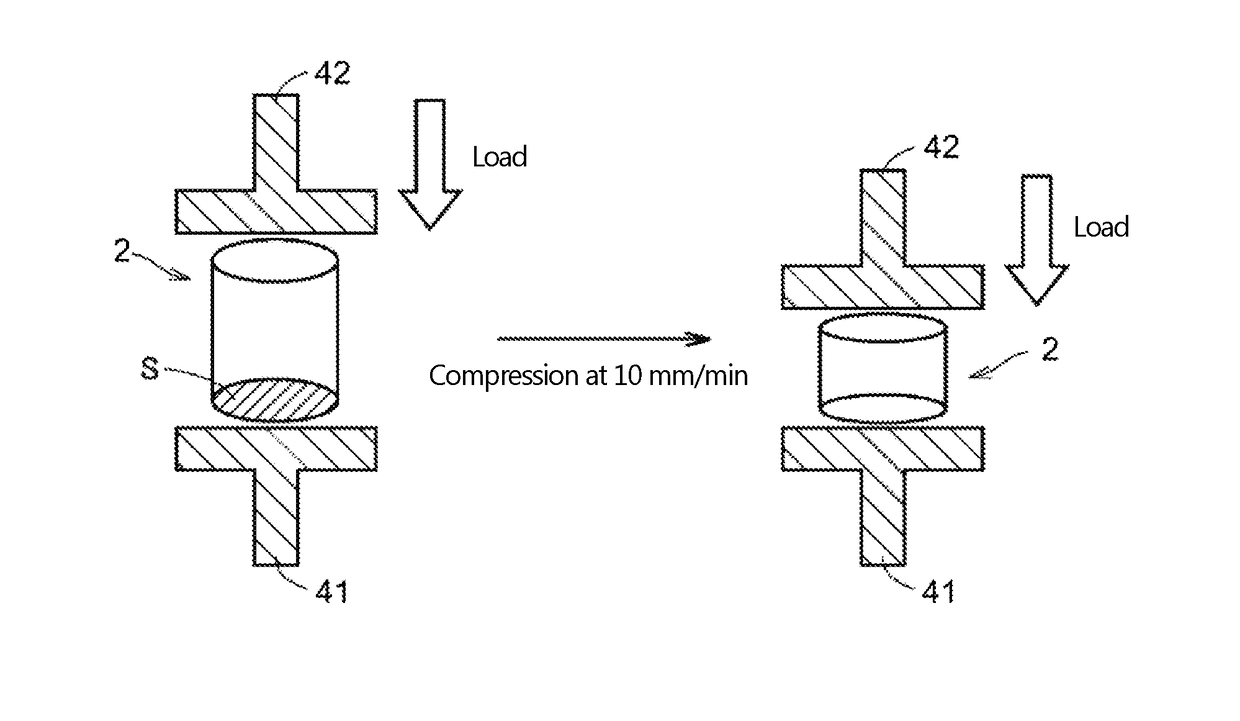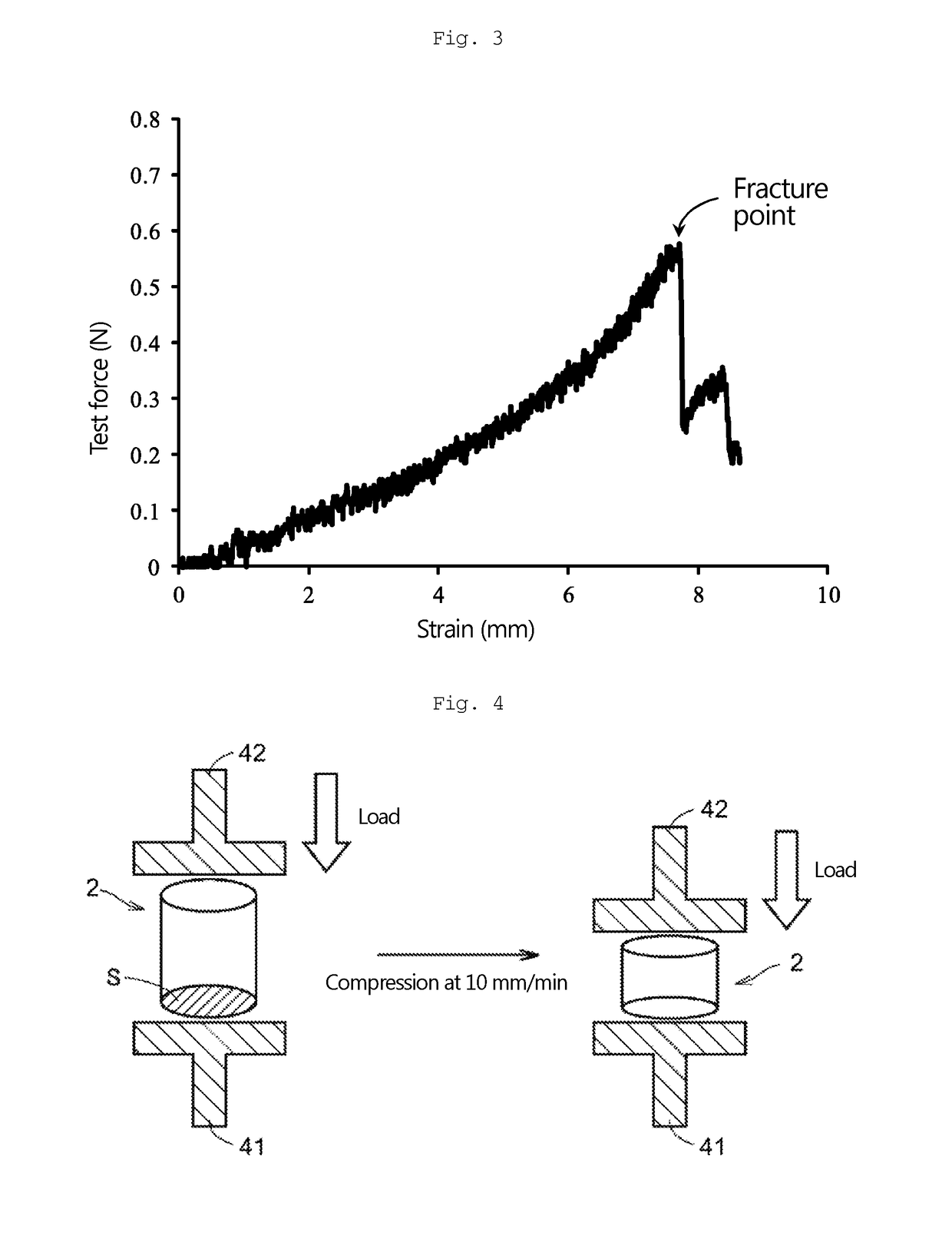Porous composite, bone regeneration material, and method for producing porous composite
a porous composite and bone regeneration technology, applied in tissue regeneration, prosthesis, medical science, etc., can solve the problems of poor shape-imparting properties of ocp, difficult to apply ocp alone to regenerate an extensive bone defect region or the like, and achieve excellent processability, high compressive strength, and high bending strength.
- Summary
- Abstract
- Description
- Claims
- Application Information
AI Technical Summary
Benefits of technology
Problems solved by technology
Method used
Image
Examples
example 1
(1) Preparation of OCP
[0068]Liquid 1 and liquid 2 for preparation of OCP were prepared in the following manner.
Liquid 1: 31.2 g of sodium dihydrogen phosphate dihydrate was dissolved in 2500 g of distilled water to prepare liquid 1.
Liquid 2: 35.2 g of calcium acetate monohydrate was dissolved in 2500 g of distilled water to prepare liquid 2.
[0069]Subsequently, liquid 1 was placed in a separable flask and heated to 70° C. using a mantle heater. While stirring liquid 1 at a rate of 250 rpm using a stirrer (MAZELA Z, produced by Tokyo Rikakikai Co., Ltd.) to which a stirring blade (blade diameter: 12 cm) was attached, liquid 2 was added dropwise to liquid 1 at a rate of about 28 mL / min. After completion of the dropwise addition, the mixture of liquid 1 and liquid 2 was further stirred at 70° C. at 250 rpm for 2 hours.
[0070]The precipitate produced in the above mixture was then filtered through a membrane filter (pore size: 3 μm; A300A293C, produced by Advantec Toyo Kaisha, Ltd.) and co...
example 2
[0075]In Example 2, porous composites (OCP / collagen composites) were produced in the same manner as in Example 1, except that type-I collagen- and type-III collagen-containing pig dermis-derived collagen with a low NaCl content was used to prepare porous composites. The low-salt collagen was prepared in the following manner.
Preparation of Low-Salt Collagen
[0076]One part by weight of pig dermis-derived collagen containing type-I collagen and type-III collagen (NMP Collagen PS, produced by NH Foods Ltd.) was dissolved in 200 parts by weight of 4° C. cooled distilled water to obtain an about 0.5 wt. % collagen solution. The amount of NaCl contained in the pig dermis-derived collagen was 4%. While maintaining the solution temperature at 4° C., an aqueous sodium hydroxide solution was added to the aqueous collagen solution to adjust the pH to about 8.0, thus obtaining a collagen suspension. The collagen suspension was placed in a centrifuge bottle, and centrifuged by a centrifugal separa...
example 3
[0077]In Example 3, porous composites (OCP / collagen composites) were produced in the same manner as in Example 1, except that phosphate buffered saline (PBS) was added to the collagen suspension of Example 1 to adjust the ionic strength to 0.05.
PUM
| Property | Measurement | Unit |
|---|---|---|
| compressive strength | aaaaa | aaaaa |
| bending strength | aaaaa | aaaaa |
| pore size | aaaaa | aaaaa |
Abstract
Description
Claims
Application Information
 Login to View More
Login to View More - R&D
- Intellectual Property
- Life Sciences
- Materials
- Tech Scout
- Unparalleled Data Quality
- Higher Quality Content
- 60% Fewer Hallucinations
Browse by: Latest US Patents, China's latest patents, Technical Efficacy Thesaurus, Application Domain, Technology Topic, Popular Technical Reports.
© 2025 PatSnap. All rights reserved.Legal|Privacy policy|Modern Slavery Act Transparency Statement|Sitemap|About US| Contact US: help@patsnap.com



